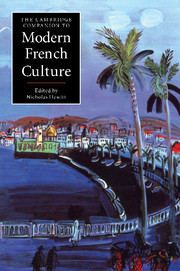Book contents
- Frontmatter
- Introduction: French culture and society in the twentieth century
- 1 Modern France: history, culture and identity, 1900-1945
- 2 Culture and identity in postwar France
- 3 Architecture, planning and design
- 4 The mass media
- 5 Consumer culture: food, drink and fashion
- 6 Language: divisions and debates
- 7 Intellectuals
- 8 Religion, politics and culture in France
- 9 The third term: literature between philosophy and critical theory
- 10 Narrative fiction in French
- 11 Poetry
- 12 Theatre
- 13 Music
- 14 The visual arts
- 15 Cinema
- Index
Introduction: French culture and society in the twentieth century
Published online by Cambridge University Press: 28 May 2006
- Frontmatter
- Introduction: French culture and society in the twentieth century
- 1 Modern France: history, culture and identity, 1900-1945
- 2 Culture and identity in postwar France
- 3 Architecture, planning and design
- 4 The mass media
- 5 Consumer culture: food, drink and fashion
- 6 Language: divisions and debates
- 7 Intellectuals
- 8 Religion, politics and culture in France
- 9 The third term: literature between philosophy and critical theory
- 10 Narrative fiction in French
- 11 Poetry
- 12 Theatre
- 13 Music
- 14 The visual arts
- 15 Cinema
- Index
Summary
In 1989 France celebrated the Bicentennial of the Revolution which overthrew the ancien régime and established the First Republic. Culminating in a spectacular display on the Place de la Concorde on 14 July, the celebrations were an affirmation of France's revolutionary origins and its republican tradition, a tradition which, through the first two thirds of the nineteenth century, were eclipsed by Bonapartism but which, with the hiatus of the Occupation, had run uninterrupted from 1871. The events in Paris on 14 July 1989 were important as a statement about France's political and social identity at the end of the twentieth century, but they also adopted a cultural format of extreme theatricality in which high cultural and popular cultural traditions merged: the evening's climax consisted of the American soprano Jessye Norman singing the Marseillaise whilst circling the obelisk at the centre of the Placede la Concorde entwined in a huge tricolore flag. Not for the first time did France choose to celebrate its historical origins with a cultural event of high theatricality which also adopted the format of the carnival. At the same time, the Bicentennial celebrations were by no means the result of spontaneous or piecemeal enthusiasm. On the contrary, they were the culmination of years of planning at the highest levels of the State, overseen and orchestrated by the Minister of Culture, Jack Lang. As such, they were confirmation of the central role of the State in the operation of late twentieth-century, as early twentieth-century, France, and of the importance it accords to culture as a means of affirming national identity.
- Type
- Chapter
- Information
- The Cambridge Companion to Modern French Culture , pp. 1 - 16Publisher: Cambridge University PressPrint publication year: 2003



